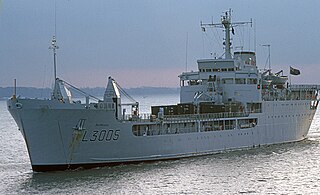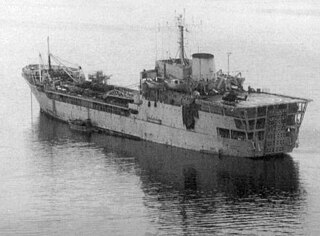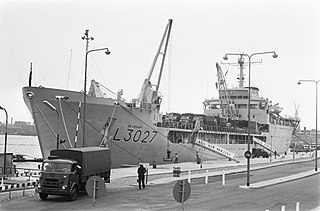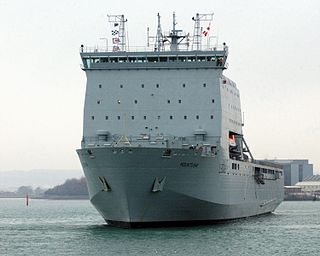
RFA Sir Galahad (L3005) was a Round Table-class landing ship logistics vessel belonging to the Royal Fleet Auxiliary (RFA) of the United Kingdom. The ship saw service in the Falklands War of 1982, where she was bombed and set afire at Fitzroy on 8 June.
Three ships of the Royal Navy and Royal Fleet Auxiliary have been named Sir Galahad, after the knight of Arthurian legend.

RFA Sir Galahad (L3005) was a landing ship logistics (LSL) of the Royal Fleet Auxiliary, later in service with the Brazilian Navy as the Garcia D'Avila.

RFA Sir Bedivere (L3004) was a Landing Ship Logistic of the Round Table class. She saw service in the Falklands War, the Persian Gulf and Sierra Leone. In 2009, she was commissioned into the Brazilian Navy and renamed NDCC Almirante Saboia (G-25), where she saw service in Haiti.

RFA Sir Percivale (L3036) was a Round Table class landing ship logistics (LSL) vessel belonging to the Royal Fleet Auxiliary of the United Kingdom.

TV Sir Tristram (L3505) formerly RFA Sir Tristram, is a Round Table-class landing ship logistics that was converted to a Special Forces Training Vessel in 2008. She was launched in 1966, and accepted into British Army service in 1967. As with others of her class, she was transferred to the Royal Fleet Auxiliary in 1970, and was crewed by British officers and Hong Kong Chinese sailors. The ship saw service in the Falklands War of 1982, and was badly damaged at Fitzroy on 8 June.
This is a list of the naval forces from the United Kingdom that took part in the Falklands War, often referred to as "the Task Force" in the context of the war. For a list of naval forces from Argentina, see Argentine naval forces in the Falklands War.

RFA Sir Lancelot (L3029) was the lead ship and prototype of the Round Table class landing ship logistics, an amphibious warfare design operated by the British Armed Forces.

HMAS Choules (L100) is a Bay-class landing ship that served with the Royal Fleet Auxiliary (RFA) from 2006 to 2011, before being purchased by the Royal Australian Navy (RAN). The vessel was built as RFA Largs Bay by Swan Hunter in Wallsend, Tyne and Wear. She was named after Largs Bay in Ayrshire, Scotland, and entered service in November 2006. During her career with the RFA, Largs Bay served as the British ship assigned to patrol the Falkland Islands in 2008, and delivered relief supplies following the 2010 Haiti earthquake.

RFA Lyme Bay is a Bay-class auxiliary dock landing ship of the British Royal Fleet Auxiliary (RFA). Ordered from Swan Hunter in 2000, the ship was launched in 2005. However, cost overruns and delays saw the shipbuilder removed from the project, and the incomplete ship was towed to Govan for finishing by BAE Systems Naval Ships. Lyme Bay entered service in late 2007; the last ship of the class to join the RFA.

RFA Mounts Bay is a Bay-class auxiliary landing ship dock of the Royal Fleet Auxiliary. She is named after Mount's Bay in Cornwall.

RFA Cardigan Bay is a Bay-class landing ship dock of the Royal Fleet Auxiliary (RFA). Built by BAE Systems, the ship was dedicated into the RFA at the end of 2006.

RFA Sir Geraint (L3027) was a Landing Ship Logistic of the Round Table class. She saw service in the Falklands War and Sierra Leone.

The Bay class is a ship class of four dock landing ships built for the British Royal Fleet Auxiliary (RFA) during the 2000s. They are based on the Dutch-Spanish Royal Schelde Enforcer design, and replaced the Round Table-class logistics ships. Two ships each were ordered from Swan Hunter and BAE Systems Naval Ships. Construction work started in 2002, but saw major delays and cost overruns, particularly at Swan Hunter's shipyard. In mid-2006, Swan Hunter was stripped of work, and the incomplete second ship was towed to BAE's shipyard for completion. All four ships, Largs Bay, Lyme Bay, Mounts Bay, and Cardigan Bay had entered service by 2007.

A dock landing ship is an amphibious warfare ship with a well dock to transport and launch landing craft and amphibious vehicles. Some ships with well decks, such as the Soviet Ivan Rogov class, also have bow doors to enable them to deliver vehicles directly onto a beach. Modern dock landing ships also operate helicopters.

The 1982 British military campaign to recapture the Falkland Islands depended on complex logistical arrangements. The logistical difficulties of operating 7,000 nautical miles from home were formidable. The Argentine invasion of the Falkland Islands came at a time when the Royal Navy was experiencing a reduction in its amphibious capability, but it still possessed the aircraft carriers HMS Hermes and Invincible, the landing platform dock (LPD) ships HMS Fearless and Intrepid, and six landing ship logistics (LSL) ships. To provide the necessary logistic support, the Royal Navy's ships were augmented by ships taken up from trade (STUFT).

The Round Table class was a small class of trawlers built for the British Royal Navy in 1941–1942. The class were built by two Aberdeen shipbuilding firms Hall, Russell & Company and J. Lewis & Sons Ltd.
















